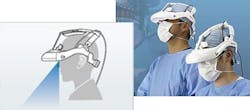Sony launches OLED-based, head-mounted endoscopic image display
Tokyo, Japan--Sony Corporation launched a head-mount image processing unit capable of receiving and outputting endoscope image signals, or controlling video images, which can then be displayed in 3D or 2D on an accompanying head-mounted monitor. Compatible with a 3D surgical laparoscope, the head-worn display (HWD) enables images that meet the surgical demands of medical professionals.
The new unit maximizes the technological advantages of OLED (organic light-emitting diode) panels to enable extremely detailed image representation of the target area. These characteristics include high resolution, superb reproduction of blacks, excellent video image response times, and precise color reproduction. Two panels are fitted inside the monitor: one each for the left and right eye. Independent HD images are displayed on the left and right panels respectively with no crosstalk (the phenomenon of images appearing in duplicate), in order to display the target area in high definition, with faithful color reproduction and highly-precise information relating to depth.
In conventional laparoscopic procedures, surgeons generally have to check endoscopic images on an external monitor as they perform the surgery, restricting their posture and movement. However, Sony's head-mounted display enables the surgeons to position themselves flexibly as they perform their procedures, supporting smooth workflow procedures in addition to the benefit of a 3D image display.
Furthermore, Sony's 'Picture in Picture (PinP)' capability enables two images to be displayed simultaneously. Images can also be flipped to the left, right, up, or down, for different display perspectives. For example, if a team of surgeons are working together in the same operating theater, this feature can be utilized to enable laparoscopic images from the operating surgeon to be viewed by other surgeons or assistants standing in other positions, and each can view the laparoscopic images from their respective viewing angle.
The estimated market price for the head-mounted monitor and image processing unit is 1.5 million Japanese yen or a little more than $15,000 US dollars. Its use has been approved in Japan; use in other countries is pending.
SOURCE: Sony; http://www.sony.net/SonyInfo/News/Press/201307/13-085E/

Gail Overton | Senior Editor (2004-2020)
Gail has more than 30 years of engineering, marketing, product management, and editorial experience in the photonics and optical communications industry. Before joining the staff at Laser Focus World in 2004, she held many product management and product marketing roles in the fiber-optics industry, most notably at Hughes (El Segundo, CA), GTE Labs (Waltham, MA), Corning (Corning, NY), Photon Kinetics (Beaverton, OR), and Newport Corporation (Irvine, CA). During her marketing career, Gail published articles in WDM Solutions and Sensors magazine and traveled internationally to conduct product and sales training. Gail received her BS degree in physics, with an emphasis in optics, from San Diego State University in San Diego, CA in May 1986.
